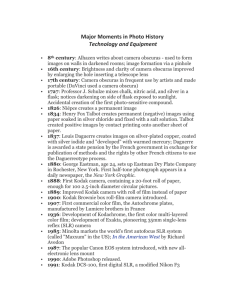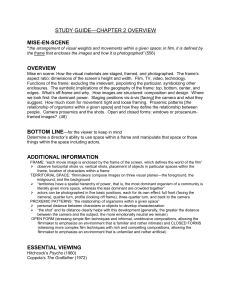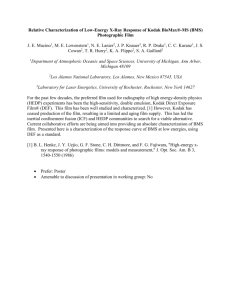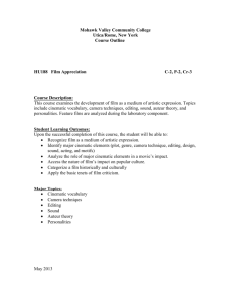Telephone Exercise
advertisement
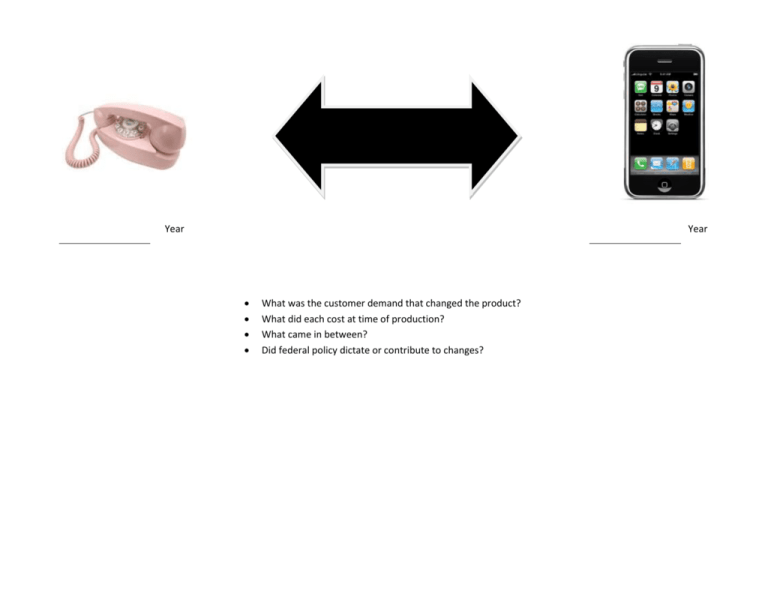
Year Year What was the customer demand that changed the product? What did each cost at time of production? What came in between? Did federal policy dictate or contribute to changes? 1876 cost: $20 = ~$413.00 in 2009 1958 2007 ~$199 for an 8G 1876: Alexander Graham Bell invents the telephone 1881: First Telephone Yellow Pages Directory 1887: First coin-operated telephone installed in the Hartford Bank by the payphone’s inventor William Gray 1891: First dial phone. 512,000 phone in the U.S. 1915: First “official” coast-to-coast call is made from Alexander Graham Bell in New York City to Thomas Watson in San Francisco 1928: Herbert Hoover becomes first president of the United States with a phone on his desk. Until this time, the President talked on a phone from a booth outside his executive office. 1957: Field tests for the first pages begin in Allentown and Bethlehem, PA 1958: Princess Phone introduced. First phone with a lighted dial, became a part of American pop culture. 1960: The first Touch-Tone telephones are test-marketed in Findlay, OH. These telephones had 10 buttons, rather than the 12 buttons of today. 1963: Hotline link established between White House and Kremlin following the Cuban missile crisis 1968: 911 chosen as the nationwide emergency number. The nation’s telephone companies agree to make this three-digit sequence unavailable as an exchange number 1972: First e-mail message. The term “Internet” is used for the first time two years later, but the concept of the Internet as we know it today didn’t evolve until later 1984: First Cellular phones 1990: The World Wide Web is born, marking the beginning of the Internet as we know it today. Most Americans get Internet connections through their phone lines 1991: Caller ID introduced. Controversial at the time. Caller ID has become America’s most popular add-on feature 2000: “Thin Phone” which integrates wireless Internet access with local wireless phone service – becomes widely available. Lets customers stay connected with everything from Web pages to voice and e-mail-all while on the move. Year Year What was the customer demand that changed the product? What did each cost at time of production? What came in between? Did federal policy dictate or contribute to changes? 1891 Cost: $150 = ~$3650 in 2009 by 1899 cost had dropped to $20 = ~534 in 2009 1877 1878 1887 1891 1899 1925 1927 1935 1940 1948 1949 1955 1956 1975 1980 1982 2001 1983 Cost: w/o radio $100 = ~ $215 in 2009 Cost: w/ radio $120 = ~258 in 2009 2001 Cost: $400 =~$485 in 2009 Thomas Alva Edison, working in his lab, succeeds in recovering Mary's Little Lamb from a strip of tinfoil wrapped around a spinning cylinder. The first music is put on record: cornetist Jules Levy plays "Yankee Doodle." Emile Berliner is granted a patent on a flat-disc gramophone, making the production of multiple copies practical. Price for a phonograph $150 = ~$3650 in 2009 Price for a phonograph $20 = ~$534 in 2009 The first electrically recorded 78 rpm disks appear. "The Jazz Singer" is released as the first commercial talking picture, using Vitaphone sound on disks synchronized with film BASF prepares the first plastic-based magnetic tapes. Walt Disney's "Fantasia" is released, with eight-track stereophonic sound. The microgroove 33-1/3 rpm long-play vinyl record (LP) is introduced by Columbia Records. RCA introduces the microgroove 45 rpm, large-hole, 7-inch record and record changer/adaptor Ampex develops "Sel-Sync" (Selective Synchronous Recording), making audio overdubbing practical. Les Paul makes the first 8-track recordings using the "Sel-Sync" method. Digital tape recording begins to take hold in professional audio studios. Sony introduces a palm-sized stereo cassette tape player called a "Walkman." Sony releases the first CD player, the Model CDP-101. Apple releases the original iPod costing $400 Year Year What was the customer demand that changed the product? What did each cost at time of production? What came in between? Did federal policy dictate or contribute to changes? 1887 1879 2009 Cost: $14.99 If we define the stapler as a machine for fastening papers together, then the earliest recorded account of a stapler comes from 18th century France. The first magazine-fed, loose-wire stapler was invented in 1877 by Daniel M. Somers of New York, NY. Before this device, staplers had to be reloaded with a single staple after every use Somers's device used a magazine that was loaded with loose staples. After one staple was used, another was automatically advanced into place by a spring. Year Year What was the customer demand that changed the product? What did each cost at time of production? What came in between? Did federal policy dictate or contribute to changes? 16500BCE The earliest known maps are of the sky, not the earth 2009 cost: ~$150-800 1938 Between 1938-1940, I.I. Rabi invents molecular-beam magnetic resonance at Columbia University in 1938. He and his colleagues apply magnetic resonance to fundamental studies of atoms and molecules. Possibility of atomic clock to measure gravitational red shift is discussed. Rabi is awarded the Nobel Prize for this work in 1944. 1949 Norman Ramsey invents separated-oscillatory-field resonance method at Harvard University, for which he was awarded the Nobel Prize in 1989. Jerrold Zacharias proposes using Ramsey's method to create cesium-beam "fountain" clock that would be accurate enough to measure gravitational red shift. 1954 Charles Townes at Columbia University demonstrates operation of the first maser based on emission of radiation from ammonia molecules. Townes shared the 1964 Nobel Prize in physics. 1954 Between 1954-1956, Zacharias and National Company develop the first self-contained portable atomic clock, the Atomichron. 1957 Sputnik is launched in October by the Soviet Union. Satellite Doppler tracking is inaugurated at MIT Lincoln Laboratory and Johns Hopkins Applied Physics Laboratory (APL). Navy Transit program is started at APL in December. 1960 Ramsey and students Kleppner and Goldenberg operate hydrogen maser at Harvard University. 1960 Between 1960-1965, rubidium optically pumped clock is introduced. Cesium frequency standards are installed in most international time-standard laboratories. 1964 Between 1964-1965, first position fix from a Transit satellite is computed aboard Polaris submarine. 1967 Transit system is made available to civilian community. 1968 Standards of a Defense Navigation Satellite System are defined. 1974 1977 1978 1989 1993 1996 First GPS test satellite, from Timation program, is launched to test rubidium clocks and time-dissemination techniques. Test satellite incorporating principal features of later GPS satellites, including first cesium clocks in space, is launched. Between 1978-1985, ten prototype GPS satellites are launched, built by Rockwell International. Between 1989-1993, series of 24 satellites are launched at about 6 per year. Final GPS satellite is launched on June 26, 1993. White House announces that a higher level GPS accuracy will be available to everyone. Year Year What was the customer demand that changed the product? What did each cost at time of production? What came in between? Did federal policy dictate or contribute to changes? Ancient times: Camera obscuras used to form images on walls in darkened rooms; image formation via a pinhole 16th century: Brightness and clarity of camera obscuras improved by enlarging the hole inserting a telescope lens 17th century: Camera obscuras in frequent use by artists and made portable in the form of sedan chairs 1816: Nicéphore Niépce combines the camera obscura with photosensitive paper 1826: Niépce creates a permanent image 1861-65: Mathew Brady and staff (mostly staff) covers the American Civil War, exposing 7000 negatives 1888: First Kodak camera, containing a 20-foot roll of paper, enough for 100 2.5-inch diameter circular pictures. 1889: Improved Kodak camera with roll of film instead of paper 1900: Kodak Brownie box roll-film camera introduced. 1906: Availability of panchromatic black and white film and therefore high quality color separation color photography. 1907: First commercial color film, the Autochrome plates, manufactured by Lumiere brothers in France 1917: Nippon Kogaku K.K., which will eventually become Nikon, established in Tokyo. 1924: Leitz markets a derivative of Barnack's camera commercially as the "Leica", the first high quality 35mm camera. 1934: Fuji Photo Film founded. By 1938, Fuji is making cameras and lenses in addition to film. 1936: Development of Kodachrome, the first color multi-layered color film; development of Exakta, pioneering 35mm single-lens reflex (SLR) camera 1948: Hasselblad in Sweden offers its first medium-format SLR for commercial sale; Pentax in Japan introduces the automatic diaphragm; Polaroid sells instant black and white film 1963: First color instant film developed by Polaroid; Instamatic released by Kodak; first purpose-built underwater introduced, the Nikonos 1987: The popular Canon EOS system introduced, with new all-electronic lens mount 1990: Adobe Photoshop released. 1991: Kodak DCS-100, first digital SLR, a modified Nikon F3 1992: Kodak introduces PhotoCD 2000: Camera phone introduced in Japan by Sharp/J-Phone 2001: Polaroid goes bankrupt 2003: Four-Thirds standard for compact digital SLRs introduced with the Olympus E-1; Canon Digital Rebel introduced for less than $1000 2004: Kodak ceases production of film cameras 2005: Canon EOS 5D, first consumer-priced full-frame digital SLR, with a 24x36mm CMOS sensor for $3000 Year Year What was the customer demand that changed the product? What did each cost at time of production? What came in between? Did federal policy dictate or contribute to changes? 1971 – Umatic But the cost—US$1,395 for a combination TV/VCR, or $7,069 in 2007 dollars 1975 Betamax, which came with a 19" Trinitron TV, cost $2495 in 1975. ($9940 in 2009) 1976 JVC VHS, by 1985, you could buy a VHS recorder for $299 ($596 in 2009) While VHS machines' lower retail price was a major factor, the principal battleground proved to be recording time. The original Sony Betamax video recorder for the NTSC television system could only record for 60 minutes. JVC's VHS could manage 120 minutes, followed by RCA's entrance into the market with a 240 minute recorder. These challenges sparked a mini-war to see who could achieve the longest recording time. RCA felt the recording time was too short, insisting that they needed at least a 4-hour recording time (reportedly because that was the length of an average televised U.S. football game). By 1980, out of an estimated 100,000 homes with VCRs, 70% were rented, and the presence of three (the third being Video 2000) competing formats meant that renting was an even more attractive choice, since a small fortune (about £2000 or $3900 in today's prices) could be spent on a system which may become obsolete. By the time Betamax machines became easier to rent, VHS had already claimed 70% of the market. 1997 DVDs are launched 1997: NetFlix.com, Inc. is formed in California by Reed Hastings and Marc Randolph. 1998: The company begins offering DVD rentals and sales. 1999: Sales are halted; Group Arnault invests $30 million in the firm and a subscription plan debuts. 2000: Revenue sharing deals are signed with Warner Brothers and Columbia film studios; CineMatch is introduced. 2001: A partnership with Best Buy gives Netflix exposure in the chain's 1,800 stores. 2002: The company goes public and changes its name to Netflix, Inc. $9.95/month for unlimited one-at-a-time rental 2003: Subscribers top 1,000,000, and Netflix has its first profitable quarter.
